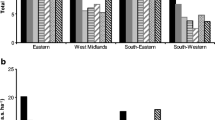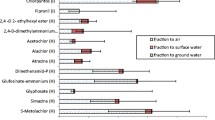Abstract
Purpose
Residues in field crops grown and harvested for human consumption are the main contributor to overall human exposure toward agricultural pesticides for the general population. However, exposure from crop residues is currently not considered in life cycle assessment practice. We therefore present a consistent framework for characterizing human toxicological impacts associated with pesticides applied to agricultural crops in the frame of life cycle impact assessment based on state-of-the-art data and methods.
Methods
We combine a dynamic multicrop plant uptake model designed for evaluating human exposure to residues for a wide range of pesticide-crop combinations with latest findings of pesticide dissipation kinetics in crops and post-harvest food processing. Outcome is a set of intake fractions and characterization factors for 875 organic pesticides and six major food crops along with specific confidence intervals for each factor.
Results and discussion
Intake fractions aggregating exposure via crop residues and exposure via fractions lost to air and soil for pesticides applied to agricultural crops vary between 10−8 and 10−1 kg intake per kilogram applied as a function of pesticide and crop. Intake fractions are typically highest for lettuce and tomato and lowest for potato due to differences in application times before crop harvest and soil as additional barrier for uptake into potato tubers. Uncertainty in intake fractions is mainly associated with dissipation dynamics in crops, where results demonstrate that using pesticide- and crop-specific data is crucial. Combined with the uncertainty in effect modeling, characterization factors per pesticide and crop show squared geometric mean standard deviations ranging from 38 to 15,560 over a variability range across pesticide-crop combinations of 10 orders of magnitude.
Conclusions
Our framework is operational for use in current life cycle impact assessment models, is made available for USEtox, and closes an important gap in the assessment of human exposure to pesticides. For ready use in life cycle assessment studies, we present pesticide-crop combination-specific characterization factors normalized to pesticide mass applied and provide default data for application times and loss due to post-harvest food processing. When using our data, we emphasize the need to consult current pesticide regulation, since each pesticide is registered for use on certain crops only, which varies between countries.





Similar content being viewed by others
References
Andersson K (2000) LCA of food products and production systems. Int J Life Cycle Assess 5:239–248
BASF (2012) HEADLINE® EC fungicide product label. BASF Canada Inc., Mississauga
Bayer (2014) Pflanzenschutz-Empfehlungen 2014. Bayer AG CropScience, Zollikofen
Bennett DH, McKone TE, Evans JS, Nazaroff WW, Margni MD, Jolliet O, Smith KR (2002) Defining intake fraction. Environ Sci Technol 36:207A–211A
BVL (2015) Online data base of plant protection products. Bundesamt für Verbraucherschutz und Lebensmittelsicherheit, Berlin. <https://apps2.bvl.bund.de/psm/jsp/>
Caldas ED, Jardim ANO (2012) Exposure to toxic chemicals in the diet: is the Brazilian population at risk? J Expo Sci Environ Epidemiol 22:1–15
DEFRA (2006) Web-integrated framework for addressing uncertainty and variability in pesticide risk assessment, Department for Environment Food and Rural Affairs
Dickson-Spillmann M, Siegrist M, Keller C, Wormuth M (2009) Phthalate exposure through food and consumers’ risk perception of chemicals in food. Risk Anal 29:1170–1181
Dubus IG, Brown CD, Beulke S (2003) Sources of uncertainty in pesticide fate modelling. Sci Total Environ 317:53–72
European Commission (2004) 2004/248/EC: commission decision of 10 March 2004 concerning the non-inclusion of atrazine in Annex I to Council Directive 91/414/EEC and the withdrawal of authorisations for plant protection products containing this active substance, Brussels
European Commission (2006) Special Eurobarometer 238, Wave 64/1—risk issues, Brussels
European Commission (2009) Regulation (EC) No 1107/2009 of the European parliament and of the council of 21 October 2009 concerning the placing of plant protection products on the market and repealing Council Directives 79/117/EEC and 91/414/EEC, Brussels
European Commission (2010) International reference life cycle data system (ILCD) handbook: framework and requirements for LCIA models and indicators, First Edition, Brussels
European Commission (2011) Commission implementing regulation (EU) No 540/2011 of 25 May 2011 implementing regulation (EC) No 1107/2009 of the European parliament and of the council as regards the list of approved active substances, Brussels
Fantke P, Juraske R (2013) Variability of pesticide dissipation half-lives in plants. Environ Sci Technol 47:3548–3562
Fantke P, Charles R, de Alencastro LF, Friedrich R, Jolliet O (2011a) Plant uptake of pesticides and human health: dynamic modeling of residues in wheat and ingestion intake. Chemosphere 85:1639–1647
Fantke P, Juraske R, Antón A, Friedrich R, Jolliet O (2011b) Dynamic multicrop model to characterize impacts of pesticides in food. Environ Sci Technol 45:8842–8849
Fantke P, Friedrich R, Jolliet O (2012a) Health impact and damage cost assessment of pesticides in Europe. Environ Int 49:9–17
Fantke P, Wieland P, Juraske R, Shaddick G, Sevigné E, Friedrich R, Jolliet O (2012b) Parameterization models for pesticide exposure via crop consumption. Environ Sci Technol 46:12864–12872
Fantke P, Wieland P, Wannaz C, Friedrich R, Jolliet O (2013) Dynamics of pesticide uptake into plants: from system functioning to parsimonious modeling. Environ Model Softw 40:316–324
Fantke P, Gillespie B, Juraske R, Jolliet O (2014) Estimating half-lives for pesticide dissipation from plants. Environ Sci Technol 48:8588–8602
FAO (2003) Development of a framework for good agricultural practices. COAG/2003/6. Food and Agriculture Organization of the United Nations, Rome
Footprint (2014) The pesticide properties database (PPDB 2.0) of the footprint project. <http://sitem.herts.ac.uk/aeru/ppdb>
Freeman NCG (2011) Exposure science: ingestion. In: Nriagu JO (ed) Encyclopedia of environmental health. Elsevier, Burlington, pp 657–665
Ganzelmeier H, Rautmann D, Spagenberg R, Streloke M, Hermann M, Wenzelburger HJ, Walter HF (1995) Studies on the spray drift of plant protection products. Blackwell, Berlin
Hayes TB, Anderson LL, Beasley VR, de Solla SR, Iguchi T et al (2011) Demasculinization and feminization of male gonads by atrazine: consistent effects across vertebrate classes. J Steroid Biochem 127:64–73
Huijbregts MAJ, Rombouts LJA, Ragas AMJ, van de Meent D (2005) Human-toxicological effect and damage factors of carcinogenic and noncarcinogenic chemicals for life cycle impact assessment. Integr Environ Assess Manag 1:181–244
Itoiz ES, Fantke P, Juraske R, Kounina A, Antón Vallejo A (2012) Deposition and residues of azoxystrobin and imidacloprid on greenhouse lettuce with implications for human consumption. Chemosphere 89:1034–1041
Juraske R, Sanjuán N (2011) Life cycle toxicity assessment of pesticides used in integrated and organic production of oranges in the Comunidad Valenciana, Spain. Chemosphere 82:956–962
Jacobsen RE, Fantke P, Trapp S (2015) Analysing half-lives for pesticide dissipation in plants. SAR QSAR Environ Res 26:325–342
Juraske R, Antón A, Castells F (2008) Estimating half-lives of pesticides in/on vegetation for use in multimedia fate and exposure models. Chemosphere 70:1748–1755
Juraske R, Vivas CSM, Velsquez AE, Santos GG, Moreno MBB, Gomez JD, Binder CR, Hellweg S, Dallos JAG (2011) Pesticide uptake in potatoes: model and field experiments. Environ Sci Technol 45:651–657
Juraske R, Fantke P, Romero Ramírez AC, González A (2012) Pesticide residue dynamics in passion fruits: comparing field trial and modeling results. Chemosphere 89:850–855
Kaushik G, Satya S, Naik SN (2009) Food processing a tool to pesticide residue dissipation—a review. Food Res Int 42:26–40
Keikotlhaile BM, Spanoghe P, Steurbaut W (2010) Effects of food processing on pesticide residues in fruits and vegetables: a meta-analysis approach. Food Chem Toxicol 48:1–6
Kramer HJ, van den Ham WA, Slob W, Pieters MN (1996) Conversion factors estimating indicative chronic no-observed-adverse-effect levels from short-term toxicity data. B Environ Contam Tox 23:249–255
Landis WG, Chapman PM (2011) Well past time to stop using NOELs and LOELs. Integr Environ Assess Manag 7:vi–viii
Liang Y, Liu Y, Ding Y, Liu XJ (2014) Meta-analysis of food processing on pesticide residues in fruits. Food Addit Contam 31:1568–1573
Lippmann M (2009) Environmental toxicants: human exposures and their health effects, 3rd edn. Wiley, Hoboken
Lu C, Barr DB, Pearson MA, Waller LA (2008) Dietary intake and its contribution to longitudinal organophosphorus pesticide exposure in urban/suburban children. Environ Health Perspect 116:537–542
McKinlay R, Plant JA, Bell JNB, Voulvoulis N (2008) Endocrine disrupting pesticides: implications for risk assessment. Environ Int 34:168–183
Muncke J (2009) Exposure to endocrine disrupting compounds via the food chain: is packaging a relevant source? Sci Total Environ 407:4549–4559
Perrin A, Basset-Mens C, Gabrielle B (2014) Life cycle assessment of vegetable products: a review focusing on cropping systems diversity and the estimation of field emissions. Int J Life Cycle Assess 19:1247–1263
Pretty JN (2005) The pesticide detox: towards a more sustainable agriculture. Earthscan, London
Rautmann D, Streloke M, Winkler R (2001) New basic drift values in the authorisation procedure for plant protection products. Biologische Bundesanstalt für Land- und Forstwirtschaft, Berlin
Rein A, Legind CN, Trapp S (2011) New concepts for dynamic plant uptake models. SAR QSAR Environ Res 22:191–215
Rosenbaum RK, Bachmann TM, Gold LS, Huijbregts MAJ, Jolliet O, Juraske R, Koehler A, Larsen HF, MacLeod M, Margni MD, McKone TE, Payet J, Schuhmacher M, van de Meent D, Hauschild MZ (2008) USEtox—the UNEP-SETAC toxicity model: recommended characterisation factors for human toxicity and freshwater ecotoxicity in life cycle impact assessment. Int J Life Cycle Assess 13:532–546
Rosenbaum RK, Anton A, Bengoa X, Bjørn A, Brain R et al (2015) The Glasgow consensus on the delineation between pesticide emission inventory and impact assessment for LCA. Int J Life Cycle Assess 20:765–776
Roy P, Nei D, Orikasa T, Xu Q, Okadome H, Nakamura N, Shiina T (2009) A review of life cycle assessment (LCA) on some food products. J Food Eng 90:1–10
Schau EM, Fet AM (2008) LCA studies of food products as background for environmental product declarations. Int J Life Cycle Assess 13:255–264
Slob W (1994) Uncertainty analysis in multiplicative models. Risk Anal 14:571–576
Slovic P (2010) Perceptions of pesticides as risks to human health. In: Krieger R (ed) Hayes’ handbook of pesticide toxicology, 3rd edn. Academic Press, London, pp 1381–1391
Sun F, Kolvenbach BA, Nastold P, Jiang B, Ji R, Corvini PF-X (2014) Degradation and metabolism of tetrabromobisphenol A (TBBPA) in submerged soil and soil-plant systems. Environ Sci Technol 48:14291–14299
Tittlemier SA, Pepper K, Seymour C, Moisey J, Bronson R, Cao X-L, Dabeka RW (2007) Dietary exposure of Canadians to perfluorinated carboxylates and perfluorooctane sulfonate via consumption of meat, fish, fast foods, and food items prepared in their packaging. J Agric Food Chem 55:3203–3210
Tomlin CDS (2012) The pesticide manual, Sixteenthth edn. BCPC Publications, British Crop Protection Council, Hampshire
Trapp S (2015) Calibration of a plant uptake model with plant- and site-specific data for uptake of chlorinated organic compounds into radish. Environ Sci Technol 49:395–402
Udo de Haes HA, Finnveden G, Goedkoop M, Hauschild MZ, Hertwich E, Hofstetter P, Jolliet O, Klöpffer W, Krewitt W, Lindeijer E, Müller-Wenk R, Olsen S, Pennington DW, Potting J, Steen B (2002) Life-cycle impact assessment: striving towards best practice. SETAC Press, Pensacola
US-EPA (2006) Combined Decision Documents for Atrazine. United States Environmental Protection Agency, Washington, DC
US-EPA (2012) Estimation programs interface SuiteTM for Microsoft® Windows, v 4.11. United States Environmental Protection Agency, Washington, D.C. <http://www.epa.gov/oppt/exposure/pubs/episuite.htm>
van de Zande JC, Michielsen JMGP, Stallinga H (2007) Spray drift and off-field evaluation of agrochemicals in the Netherlands, Report 149. Plant Research International B. V, Wageningen
Acknowledgments
This work was financially supported by the Marie Curie project Quan-Tox (grant agreement no. 631910) funded by the European Commission under the Seventh Framework Programme.
Author information
Authors and Affiliations
Corresponding author
Additional information
Responsible editor: Llorenc Milà i Canals
Rights and permissions
About this article
Cite this article
Fantke, P., Jolliet, O. Life cycle human health impacts of 875 pesticides. Int J Life Cycle Assess 21, 722–733 (2016). https://doi.org/10.1007/s11367-015-0910-y
Received:
Accepted:
Published:
Issue Date:
DOI: https://doi.org/10.1007/s11367-015-0910-y




